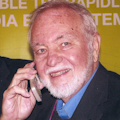We have yet to fully realize real 4G wireless systems and already there is news of 5G technology in a recent release from Samsung. Right now this 5G technology is in the research and development stage but you can relax knowing that the next wave of high speed wireless is on the way.
The fourth generation (4G) is what we all now accept as Long Term Evolution (LTE). The ITU originally said that LTE was just 3.9G and that LTE Advanced is the real 4G. But the carriers dubbed LTE as 4G so that is what it is despite formal definitions. We are not yet seeing LTE-A but it is in the works and we should be seeing some basestation and handset implementations next year. Right now, most carriers are still rolling out standard LTE where their funds and spectrum permit.
While LTE-A is theoretically capable of delivering 1 Gb/s over-the-air data, in practice, with typical environmental conditions, actual speeds will be much less than that. Besides, to get Gb/s speeds the wireless operation needs to be at a higher frequency. On top of that the carriers are running out of spectrum and the only sane solution for the future is to look at available spectrum beyond 4 GHz. The millimeter bands of 30 GHz to 300 GHz are available and offer considerable room to expand. Lower frequencies in the 11 GHz to 30 GHz range are also a potential location.
Related Articles
• Are You Ready For 5G Wireless?
• Wireless Companies Follow Roadmap Past 4G On To 5G
• LTE Small-Cell Software Evolves
No thanks to the physics of radio waves, the maximum range at those frequencies is much shorter than at lower frequencies. The solution is more power. One way to get that extra range is to use high gain antennas that focus the radio waves into a beam. This is equivalent of raising the transmitter power. Phased arrays can be used to not only focus the beam but also to steer the beam in a desired direction.
Samsung’s solution is an adaptive array transceiver operating in the 28 GHz band. With 64 elements, the antenna array and transceiver have demonstrated a 1.056 Gb/s data rate over a 2 km distance. Remember that antenna size is inversely proportional to frequency. This permits a 64 element array to be very small and made on a chip even integrated with the electronics.
Ted Rappaport, a professor at NYU-Poly in his new NYU WIRELESS operation is also doing work with millimeter waves and steerable antenna arrays with great success. His research seems to validate what Samsung has done.
Another part of the 5G solution will no doubt involve small cells. Small cells are tiny basestations with more limited range than standard macro basestations. They are designed to bolt to lamp posts and sides of buildings. Small cell networks called HetNets, are expected to be rolling out this year and beyond as the carriers look for ways to spread the LTE footprint and boost data rates while using current frequency assignments. It is expected that the 5G solution will be small cells with steerable antenna arrays in the millimeter bands.
We will need that speed for the forthcoming 4K high definition video on our cell phones.
About the Author

Lou Frenzel Blog
Communications Technology
Click here to find more of Lou's articles on Electronic Design.